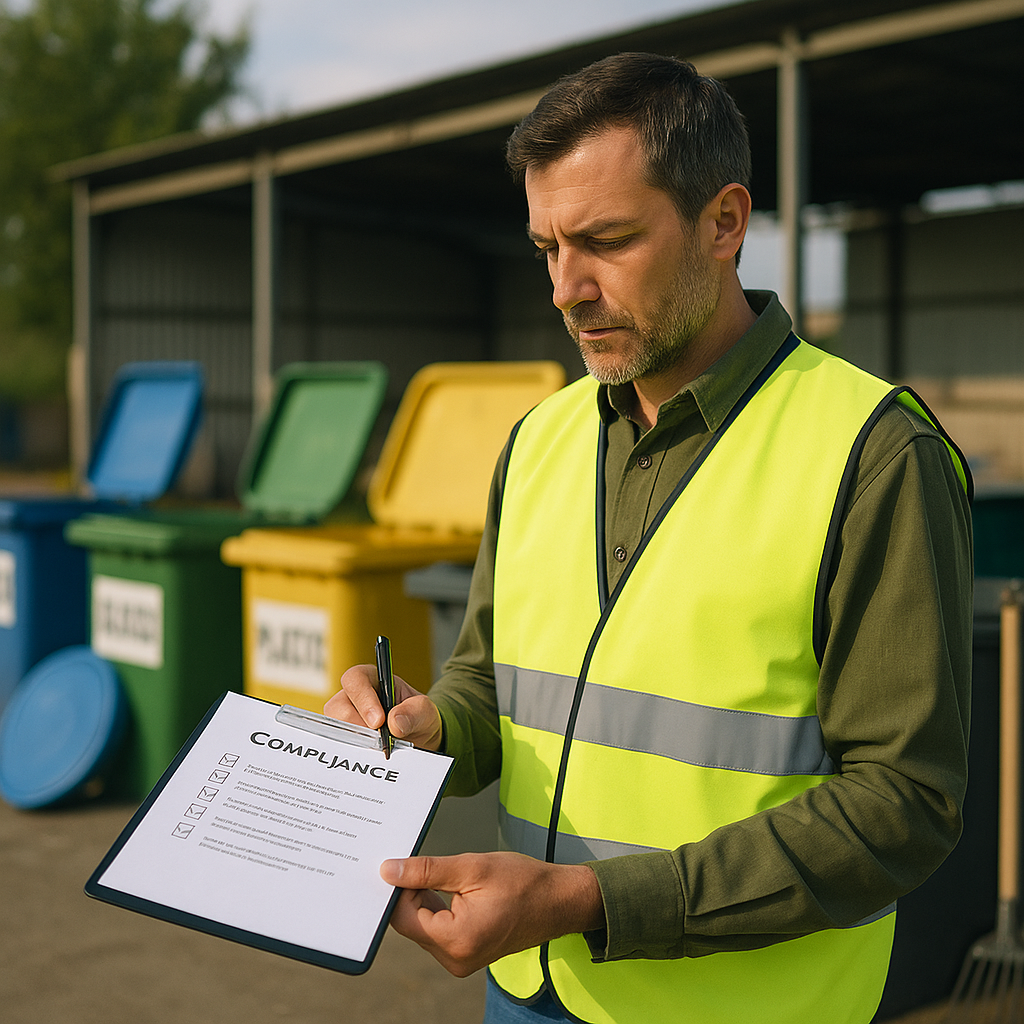5901 Botham Jean Blvd, Dallas, TX 75215
What is a Waste Audit and Why is it Important?
July 20, 2025A waste audit is a comprehensive process designed to analyze and understand exactly what types of waste your organization generates, in what quantities, and from which specific sources. This structured approach involves systematically collecting waste samples, meticulously sorting them into distinct categories (e.g., paper, plastics, organic materials, electronic waste), accurately weighing each category, and then carefully analyzing the gathered data. By thoroughly examining the composition of waste streams, organizations gain valuable insights into their disposal practices and identify opportunities for improvement.
Today, businesses encounter increasingly complex challenges in waste management. Rising landfill costs, which have surged by over 28% during the past decade, combined with tightening environmental regulations across various jurisdictions, underscore the critical need for effective waste management strategies.
Many cities and states now mandate regular waste audits, especially for businesses generating significant waste volumes. Noncompliance with these regulations can lead to substantial penalties, often amounting to tens of thousands of dollars per incident, emphasizing the financial imperative for conducting regular audits.
Why Waste Audits Matter: Key Business Advantages

Cost Savings and Operational Efficiency
Conducting detailed waste audits provides organizations with granular insights into their waste streams, enabling targeted actions to achieve significant cost savings. By identifying instances of oversized dumpsters, unnecessary collection frequencies, or recyclables mistakenly discarded as trash, businesses can optimize their waste management contracts and service schedules. This optimization often results in a 20–40% reduction in disposal costs.
Additionally, audits reveal upstream inefficiencies, such as excessive packaging, unnecessary single-use items, and redundant inventory purchases, enabling procurement teams to make informed decisions toward leaner, more sustainable purchasing practices.
Corporate Sustainability and ESG Reporting
Environmental, social, and governance (ESG) factors are increasingly scrutinized by investors, customers, and regulatory bodies. Waste audits supply critical data for calculating Scope 3 emissions—indirect emissions resulting from waste management activities—thereby enhancing the accuracy of sustainability reports and environmental disclosures.
Accurate waste data supports certification pursuits such as LEED® and TRUE Zero Waste, reinforcing brand credibility and demonstrating tangible commitment to sustainability. Enhanced transparency and robust ESG metrics help organizations secure preferential positions in supply chains and strengthen their overall market competitiveness.
Risk Mitigation and Brand Reputation
Improper disposal of hazardous or regulated waste materials poses significant regulatory and reputational risks for businesses. Regularly conducted waste audits proactively identify hazardous items like batteries, electronic waste, solvents, and medical waste that may otherwise be incorrectly discarded, triggering hefty regulatory penalties and negative public attention.
By promptly addressing identified issues, organizations can avoid compliance violations, safeguard their reputation, and demonstrate due diligence in environmental stewardship. This proactive approach enhances stakeholder trust, minimizes risk exposure, and maintains a positive brand image.
Types of Waste Audits
Baseline (Snapshot) Audits
Baseline audits provide a detailed, one-time snapshot of an organization’s waste generation patterns. These audits capture representative samples of daily operations, offering crucial initial data for organizations beginning their waste-reduction journey.
By establishing an accurate reference point, baseline audits allow businesses to set realistic goals, measure future progress, and track improvements in waste diversion efforts effectively.
Seasonal or Campaign-Specific Audits
Seasonal or campaign-specific audits are tailored to organizations with fluctuating waste generation due to seasonal activities, special events, or promotional periods. For instance, retailers often experience increased cardboard waste during holiday seasons, while educational institutions may see spikes in cafeteria waste during specific terms.
Conducting targeted audits during these periods helps identify temporary waste diversion opportunities, enabling organizations to implement targeted recycling programs and optimize their waste management strategies accordingly.
Material-Specific Audits
Material-specific audits focus exclusively on specific waste streams, such as electronic waste (e-waste), organic waste, construction debris, hazardous materials, or plastics. These detailed audits are often driven by regulatory requirements, sustainability objectives, or targeted recycling initiatives.
By conducting an in-depth analysis of particular waste streams, organizations gain precise insights into disposal habits and can develop highly specialized recycling, reuse, or waste-reduction programs tailored to address these specific materials effectively.
The Waste Audit Process: Step-by-Step

1. Goal Setting & Stakeholder Alignment
The waste audit process begins by clearly defining organizational goals—whether these involve reducing operational costs, achieving regulatory compliance, increasing recycling rates, or attaining sustainability certifications.
Effective audits require strong alignment and buy-in from all relevant stakeholders, including management, operations personnel, facilities teams, and frontline staff. Clear communication of the audit’s purpose, expected outcomes, and the roles and responsibilities of all involved parties ensures a collaborative, efficient audit process and successful implementation of resulting recommendations.
2. Sampling Design & Collection Methods
During this phase, organizations determine the scope, duration, and specific waste streams to analyze, ensuring the samples collected accurately represent typical waste generation patterns. Sampling methods may include daily or weekly collections from strategically chosen points—such as loading docks, cafeterias, office spaces, or manufacturing floors.
Containers and bags are typically color-coded or labeled for clarity, enabling accurate sorting and analysis later in the audit process. Properly designed sampling ensures reliable and actionable audit data.
3. Sorting, Weighing & Recording
Audit teams, equipped with appropriate personal protective equipment (PPE), systematically sort collected waste into predefined categories such as plastics, paper, organics, glass, metal, hazardous materials, and electronics.
Each category is accurately weighed using calibrated scales. Data is meticulously recorded, often with the assistance of digital tools like barcode scanners or mobile applications, ensuring precision and ease of analysis. Photographic documentation is also frequently used to provide visual evidence, adding transparency and accountability to the audit process.
4. Data Analysis & Interpretation
Following data collection, audit results are thoroughly analyzed to identify patterns, volumes, and waste streams requiring attention. Analysis typically involves converting raw data into actionable insights using spreadsheets or dedicated waste-characterization software, allowing auditors to highlight high-volume, high-cost, or problematic waste streams.
By interpreting these findings, organizations can pinpoint areas for targeted improvements, such as enhancing recycling rates, reducing waste generation, or correcting disposal practices for regulated materials.
5. Reporting & Action Planning
The final step involves compiling audit findings into comprehensive reports, which include detailed summaries of identified waste streams, potential cost savings, compliance issues, and environmental impact metrics. Each report typically pairs audit results with specific recommendations, outlining prioritized actions such as implementing new recycling programs, renegotiating waste-hauling contracts, introducing reusable supplies, or modifying procurement strategies. Action plans specify timelines, designate responsible parties, and project return-on-investment (ROI) estimates, providing organizations with clear guidance for successful execution and measurable results.
How Do Waste Audits Support Regulatory Compliance?

Waste audits play a pivotal role in ensuring organizations effectively navigate the complex landscape of waste management regulations, which vary significantly by jurisdiction and industry. Regularly conducted audits provide comprehensive insights into waste composition, disposal practices, and potential compliance issues, enabling organizations to proactively address regulatory risks. By identifying non-compliant practices—such as improper disposal of hazardous waste, electronic equipment, batteries, or medical waste—waste audits help prevent violations and associated financial penalties.
For instance, waste audits conducted in healthcare facilities have uncovered inadvertent disposal of regulated medical waste within general trash streams. Promptly addressing such issues has enabled these facilities to avoid severe penalties, which can exceed $13,000 per incident. Similarly, many municipalities, including San Francisco, require large waste generators to perform periodic recycling, composting, and trash audits under local ordinances like the Refuse Separation Ordinance, emphasizing the necessity of ongoing audit practices.
Comprehensive waste audit reports serve as crucial documentation during regulatory inspections, demonstrating an organization’s compliance with mandated waste management practices. These detailed records provide transparency regarding waste composition, handling processes, and final disposal or diversion methods, reinforcing an organization’s commitment to environmental responsibility and compliance.
The financial implications of regulatory noncompliance are significant. For example, in 2022, a major retailer faced a substantial $7.5 million settlement related to improper hazardous waste disposal. Consistent and thorough waste audits enable organizations to preemptively correct potentially costly mistakes, ensuring adherence to current regulations and avoiding severe penalties.
Beyond regulatory compliance, waste audits also support organizations pursuing certifications such as LEED® Certification or TRUE Zero Waste Certification, which are often prerequisites for bidding on government contracts or participating in certain markets. Providing robust audit data strengthens certification applications and demonstrates rigorous environmental management practices, enhancing an organization’s competitive edge.
Tools and Technologies That Simplify Waste Audits
Digital Scales, Barcodes, and Mobile Data Capture
Advanced digital scales provide precise measurements of waste volumes, significantly enhancing the accuracy of waste audits. These scales are often paired with handheld barcode scanners and mobile devices like rugged tablets or smartphones, streamlining data collection and eliminating manual entry errors. Mobile applications linked to cloud-based platforms instantly capture weight and category information, timestamp each entry, and produce real-time, accessible dashboards. This technology integration not only simplifies the auditing process but also allows immediate on-site decision-making and analysis.
IoT Sensors and Real-Time Bin Monitoring
Internet of Things (IoT) sensors installed within waste bins and compactors monitor real-time fill levels, alerting facilities precisely when bins reach capacity and require servicing. This technology optimizes collection schedules, reduces unnecessary waste pickups, and helps control operational costs. Additionally, photon-based scanners and composition sensors integrated into waste-handling equipment provide instantaneous feedback on contamination levels, enabling organizations to take corrective action immediately and prevent costly contamination penalties. By leveraging these advanced technologies, businesses significantly enhance the efficiency, precision, and overall effectiveness of their waste audit and management programs.
Turning Audit Insights into Actionable Waste-Reduction Strategies
Source Reduction and Re-Use Initiatives
The most effective way to manage waste is to reduce its generation from the outset. Waste audits clearly identify single-use and disposable items—such as plastic utensils, condiment packets, excessive packaging materials, and disposable dishware—that contribute significantly to organizational waste streams. Armed with audit data, organizations can implement initiatives such as transitioning to reusable products, establishing refill stations, encouraging bulk purchasing, and collaborating with suppliers for packaging reductions or take-back programs. These proactive source reduction strategies dramatically decrease waste generation, lower disposal costs, and minimize environmental impact.
Optimizing Recycling and Composting Programs
Audit insights often highlight recyclable or compostable materials incorrectly disposed of in trash bins. Organizations can leverage this information to expand and refine recycling and composting programs. Initiatives such as introducing clearly labeled recycling bins, implementing standardized bin colors for different waste streams, and providing regular staff training can significantly improve waste diversion rates. Tailored educational programs and clear, consistent signage ensure that recyclable and compostable materials are correctly managed, ultimately increasing diversion effectiveness and reducing overall landfill contributions.
Supplier Engagement & Sustainable Procurement
Engaging suppliers and procurement teams in waste reduction efforts is essential for lasting change. Organizations can share detailed waste audit findings with vendors, fostering collaboration to identify and implement sustainable procurement solutions. Examples include developing return logistics for shipping pallets, transitioning to lighter-weight or recyclable packaging materials, and opting for products that align with local recycling capabilities. Through proactive supplier engagement, businesses can significantly reduce waste at the source, enhance supply chain sustainability, and reinforce their commitment to environmental responsibility.
Conclusion: Leveraging Waste Audits for Smarter Waste Management

Waste audits have emerged as indispensable tools for organizations committed to enhancing their waste management strategies. By providing detailed, actionable insights into the types, volumes, and sources of generated waste, audits empower businesses to make informed decisions that drive substantial cost savings and operational efficiencies. Organizations that actively leverage audit findings typically experience disposal cost reductions of 30% or more through optimized waste segregation, effective recycling and composting initiatives, and precise sizing of waste containers.
Beyond financial advantages, waste audits significantly strengthen an organization’s environmental stewardship by enabling precise sustainability tracking, supporting compliance with evolving regulatory requirements, and demonstrating tangible commitments to reducing environmental footprints. Companies utilizing regular waste audits can effectively manage compliance risks, avoid costly penalties, and improve their overall reputation among customers, investors, and communities increasingly valuing sustainability practices. As environmental regulations intensify and disposal costs rise, proactive implementation of comprehensive waste audits will become increasingly essential for sustainable, efficient, and responsible business operations.
Ready to transform your organization’s approach to waste management? Contact Okon Recycling at 214-717-4083 for expert guidance on conducting effective waste audits and implementing customized, sustainable waste-management solutions tailored specifically to your organization’s unique needs.
